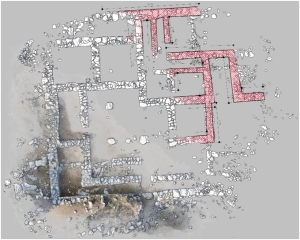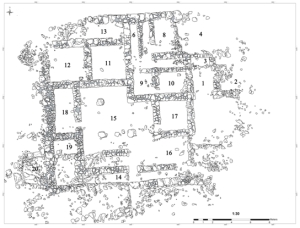The Sklavokampos Documentation Project
The Sklavokampos documentation project is an interdisciplinary project that aims to record the conservation needs of the archaeological site of the Sklavokampos Minoan second order centre as a monument. This project was a part of the Three Peak Sanctuaries project of the University of Kent and the Heritage Management Organization which aims to document and study three Minoan peak sanctuaries of the Malevyzi area which define the greater area around the plateau of Sklavokampos both in antiquity and in its current social setting. The Sklavokampos documentation project is essential for the greater integration of this particular site into the current and future social, cultural and economic networks of the area. As such the Sklavokampos documentation project begun with ethnographic, bibliographical and archival work to determine the important values of the site of Sklavokampos Minoan second order centre and its environs. It is these values that have to be documented and protected and as such both the tangible fabric and the intangible values of the site form essential parts of this project.
In parallel with the documentation of the tangible constituents of the Sklavokampos Villa, an effort has been made for the documentation and preservation of the intangible values of the monument. Values such as the archaeological and physical man-made evidence as well as the non-archaeological evidence. We designed our project as a ‘conservation program’ that is not merely about the materials for the material’s sake, but it should help preserve the materials because, they are the basis on which important values are predicated. The materials should be preserved, so as to help us preserve the values based on them. Within this context we propose a series of actions aiming to the enhancement of all the values the archaeological site that include education and training programs both for visitors as well as locals for the preservation of these intangible values.
 This is a first such effort to combine the tangible with the intangible in the same documentation project and as a result this project has recommendations for both. We firmly believe that this is the only way we can document conservation needs, since the word ‘conservation’ should not only include the tangible but also the much richer ‘intangible’.
This is a first such effort to combine the tangible with the intangible in the same documentation project and as a result this project has recommendations for both. We firmly believe that this is the only way we can document conservation needs, since the word ‘conservation’ should not only include the tangible but also the much richer ‘intangible’.
The tangible heritage documentation’s initial stage included the deforestation of the site and the surrounding slopes. That way the complete photogrammetric documentation of the site was made possible. This work was the foundation on which the orthophoto maps, the master plan and all of the walls of the monument were created. The processed draws that were created from the photogrammetric plans, were used as the foundation on which all the documentation of the building elements was materialized regarding their categorization and their current state of preservation. Those plans were used also for the precalculation of all the surfaces of the monument that have to be restored.
After the macroscopic observation, identification and characterization of the building elements and the restoration materials, samples were acquired from the local stone formations outside the perimeter of the site. All the samples were analyzed regarding the mineralogical and chemical composition, through X-ray diffraction, petrographic microscopy, scanning electron microscopy, micro Raman and FTIR spectroscopies. The elemental and stoichiometric analysis was performed through the energy dispersing spectroscopy coupled with the SEM microscope. All the analyses mentioned above were performed at the labs of the Dept. of Chemistry, UoC. At the same time, samples of all the biological specimens (biological encrustations and growths) present on the building and architectural elements of the monument were acquired. The biological species were identified and characterized after the analysis of the specimens under the stereoscope, in the labs of the Dept. of Biology, UoC. During this stage it was made possible to connect the presence of the mineral whewellite (calcium oxalate monohydrate) that was documented on the surface of the stone building elements of Sklavokampos through the Raman spectroscopic analysis, with the presence of Aspicilia calcarea which is the dominant biological encrustation present on site.
Furthermore, with all the analytical information at hand, the damage assessment study was materialized and all the weathering forms were documented. Regarding the damage assessment evaluation, a series of experiments a was designed in collaboration with the Inorganic and Analytical Chemistry lab of the Dept. of Chemical engineering of the Polytechnic School of Patras. The aim of this project is to measure the solubility rates of the local Tripolis zone type limestone, from which the monument is built of. For this
purpose several local stone underwent an artificial ageing process (dissolution) in a batch type reactor using the constant composition technique (CCT) in order to study the dissolution kinetics in variable saturation conditions. Through those experiments it has been made possible to determine the deterioration rates of the building stones of the monument that result to the characteristic karst effect formations on their surfaces. The results of this work are representative for this specific type of rock and constitute an important value of mineralogical significance connecting this aspect of the geological heritage of the area of the St. Anna gorge and the Gonies plateau with their archaeological heritage.
This work will be published in the near future within the context of a case study regarding the assessment of weathering process related to the karst effect and the Sklavokampos site.
As regards to the restoration materials and applications, samples from the local soil were collected and analyzed in order to measure the mechanical and chemical properties of this material and therefore to determine if it is efficient in order to be used as a restoration mortar for the walls of the monument. This specific type of mortar is proposed based on its exceptional performance in the archaeological site of Tylissos were it has been applied for the same purpose. The analyses of the soil samples were performed by GeoTerra Ltd as well as in the analytical chemistry and X-ray diffraction labs of the Dept. of Chemistry, UoC. All the testing and evaluation of the materials, compositions and methodologies for the restoration and preservation of the stone elements of the monument have been completed.
Although we are not entirely satisfied with the results in the way in which the values of heritage are documented homogeneously throughout this study, this has been a first effort to do so and in such we consider this study a pioneer for the future. We are grateful to the Kaplan Foundation and to the Institute for Aegean Prehistory without the help of whom we would not be able to conduct such a study.



